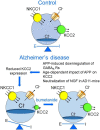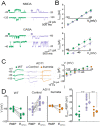Targeting the Cation-Chloride Co-Transporter NKCC1 to Re-Establish GABAergic Inhibition and an Appropriate Excitatory/Inhibitory Balance in Selective Neuronal Circuits: A Novel Approach for the Treatment of Alzheimer's Disease
- PMID: 35741668
- PMCID: PMC9221351
- DOI: 10.3390/brainsci12060783
Targeting the Cation-Chloride Co-Transporter NKCC1 to Re-Establish GABAergic Inhibition and an Appropriate Excitatory/Inhibitory Balance in Selective Neuronal Circuits: A Novel Approach for the Treatment of Alzheimer's Disease
Abstract
GABA, the main inhibitory neurotransmitter in the adult brain, depolarizes and excites immature neurons because of an initially higher intracellular chloride concentration [Cl-]i due to the delayed expression of the chloride exporter KCC2 at birth. Depolarization-induced calcium rise via NMDA receptors and voltage-dependent calcium channels is instrumental in shaping neuronal circuits and in controlling the excitatory (E)/inhibitory (I) balance in selective brain areas. An E/I imbalance accounts for cognitive impairment observed in several neuropsychiatric disorders. The aim of this review is to summarize recent data on the mechanisms by which alterations of GABAergic signaling alter the E/I balance in cortical and hippocampal neurons in Alzheimer's disease (AD) and the role of cation-chloride co-transporters in this process. In particular, we discuss the NGF and AD relationship and how mice engineered to express recombinant neutralizing anti-NGF antibodies (AD11 mice), which develop a neurodegenerative pathology reminiscent of that observed in AD patients, exhibit a depolarizing action of GABA due to KCC2 impairment. Treating AD and other forms of dementia with bumetanide, a selective KCC2 antagonist, contributes to re-establishing a proper E/I balance in selective brain areas, leading to amelioration of AD symptoms and the slowing down of disease progression.
Keywords: AD11 transgenic mice; Alzheimer’s disease; KCC2 dysfunction; NGF; bumetanide treatment; cation-chloride co-transporters; depolarizing GABAA-mediated neurotransmission.
Conflict of interest statement
The authors declare no conflict of interest.
Figures



Similar articles
-
Dysregulation of GABAergic Signaling in Neurodevelomental Disorders: Targeting Cation-Chloride Co-transporters to Re-establish a Proper E/I Balance.Front Cell Neurosci. 2022 Jan 5;15:813441. doi: 10.3389/fncel.2021.813441. eCollection 2021. Front Cell Neurosci. 2022. PMID: 35069119 Free PMC article. Review.
-
Seizures exacerbate excitatory: inhibitory imbalance in Alzheimer's disease and 5XFAD mice.Brain. 2024 Jun 3;147(6):2169-2184. doi: 10.1093/brain/awae126. Brain. 2024. PMID: 38662500 Free PMC article.
-
Beta-Amyloid (Aβ1-42) Increases the Expression of NKCC1 in the Mouse Hippocampus.Molecules. 2022 Apr 10;27(8):2440. doi: 10.3390/molecules27082440. Molecules. 2022. PMID: 35458638 Free PMC article.
-
GABAergic signaling as therapeutic target for autism spectrum disorders.Front Pediatr. 2014 Jul 8;2:70. doi: 10.3389/fped.2014.00070. eCollection 2014. Front Pediatr. 2014. PMID: 25072038 Free PMC article. Review.
-
Cation-chloride cotransporters and the polarity of GABA signalling in mouse hippocampal parvalbumin interneurons.J Physiol. 2020 May;598(10):1865-1880. doi: 10.1113/JP279221. Epub 2020 Feb 17. J Physiol. 2020. PMID: 32012273
Cited by
-
Safety, Tolerability, and EEG-Based Target Engagement of STP1 (PDE3,4 Inhibitor and NKCC1 Antagonist) in a Randomized Clinical Trial in a Subgroup of Patients with ASD.Biomedicines. 2024 Jun 27;12(7):1430. doi: 10.3390/biomedicines12071430. Biomedicines. 2024. PMID: 39062003 Free PMC article.
-
Intergenerational Perioperative Neurocognitive Disorder.Biology (Basel). 2023 Apr 7;12(4):567. doi: 10.3390/biology12040567. Biology (Basel). 2023. PMID: 37106766 Free PMC article. Review.
-
Long Non-Coding RNAs, Extracellular Vesicles and Inflammation in Alzheimer's Disease.Int J Mol Sci. 2022 Oct 29;23(21):13171. doi: 10.3390/ijms232113171. Int J Mol Sci. 2022. PMID: 36361952 Free PMC article. Review.
-
GABA Signaling: Therapeutic Targets for Neurodegenerative and Neurodevelopmental Disorders.Brain Sci. 2023 Aug 25;13(9):1240. doi: 10.3390/brainsci13091240. Brain Sci. 2023. PMID: 37759841 Free PMC article.
References
Publication types
LinkOut - more resources
Full Text Sources

